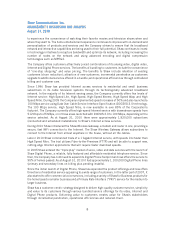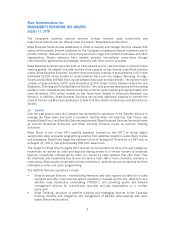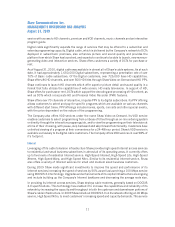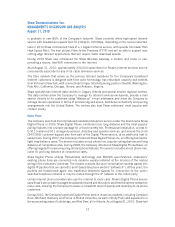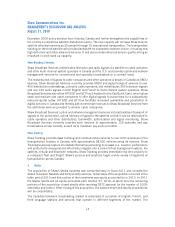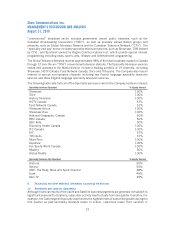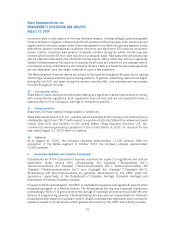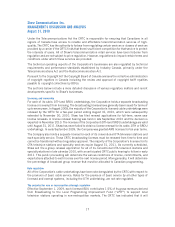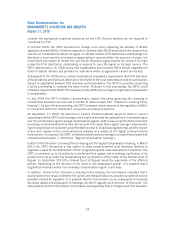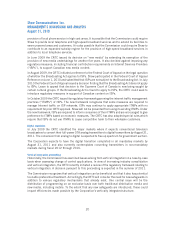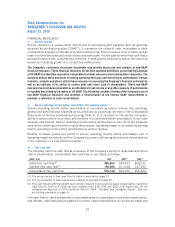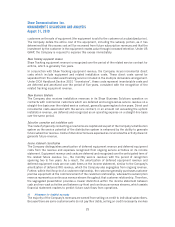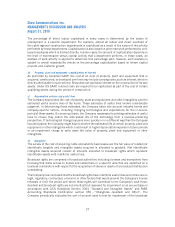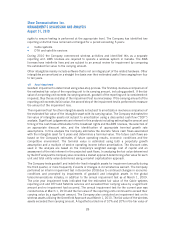Shaw 2010 Annual Report Download - page 22
Download and view the complete annual report
Please find page 22 of the 2010 Shaw annual report below. You can navigate through the pages in the report by either clicking on the pages listed below, or by using the keyword search tool below to find specific information within the annual report.consider the appropriate long-term provisions for the LPIF. Exempt systems are not required to
contribute to LPIF.
In October 2008, the CRTC announced a change in its policy regarding the delivery of distant
signals by licensed BDUs. Under the new policy, licensed cable BDUs must obtain the consent of an
over-the-air broadcaster to deliver its signal in a distant market. DTH distribution undertakings can
distribute a local over-the-air television signal without consent within the province of origin, but
must obtain permission to deliver the over-the-air television signal beyond the province of origin
unless the DTH distribution undertaking is required to carry the signal on its basic service. The
CRTC determined in its 2008 policy that broadcasters and licensed BDUs should negotiate the
terms of distant delivery but provided for arbitration where an agreement cannot be reached.
Subsequent to the 2008 policy, certain broadcasters requested a requirement that DTH distribute
all local stations and that such distribution be limited to the local transmission area of each station,
subject to negotiation between DTH licensees and broadcasters. The CRTC is currently conducting
a policy proceeding to consider the issue further. Pursuant to this proceeding, the CRTC could
introduce requirements that DTH licensees provide additional carriage or negotiated compensation
to broadcasters.
In July 2009 the CRTC initiated a proceeding to explore the policy governing the licensing of
conventional television services and a number of related issues (the “Television Licensing Policy
Hearing”). As part of that proceeding, the CRTC reviewed certain aspects of the regulation of BDUs
in connection with their distribution of over-the-air television stations.
On September 17, 2009, the Governor in Council (Federal Cabinet) issued an Order in Council
requesting that the CRTC hold hearings on the implications and the advisability of implementing an
over-the-air television signal carriage compensation regime, and to issue a report to the Government
providing recommendations that take into account the impact that a signal carriage compensation
regime would have on consumers and affordable access to broadcast programming, and the impact
of any such regime on the communications industry as it adapts to the digital communications
environment. In response, the CRTC initiated an additional proceeding to consider these issues that
commenced December 7, 2009 (the “Signal Compensation Hearing”).
Further to the Television Licensing Policy Hearing and the Signal Compensation Hearing, in March
2010 the CRTC introduced a new regime to allow privately-owned local television stations to
negotiate a value for the distribution of their programming with cable and satellite companies. The
CRTC is uncertain as to its authority to implement this regime and is seeking clarification of its
jurisdiction to do so under the Broadcasting Act, by reference of the matter to the Federal Court of
Appeal. In September 2010 the Federal Court of Appeal heard the arguments of the affected
parties. Depending on the decision of the Court or any subsequent appeal, it is possible that a
negotiated monetary and/or non-monetary compensation regime could arise.
In addition, further to the Television Licensing Policy Hearing, the Commission indicated that it
would examine the issue of whether the uplink and transport services provided by satellite service
providers should be regulated. It is possible that the Commission could, subsequent to licensing
decisions issued and subsequent to hearings, decide to regulate such services. In this event, it is
also possible that the Commission could impose new regulatory fees or charges upon this business.
18
Shaw Communications Inc.
MANAGEMENT’S DISCUSSION AND ANALYSIS
August 31, 2010


